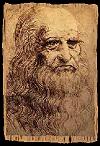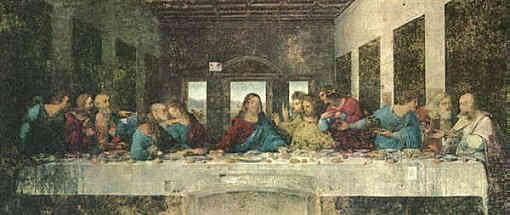|
The Duke Lodovico chose the church of Santa Maria delle Grazie as his family chapel and burial place. He then commissioned Leonardo to paint the Last Supper on the north wall of the refectory, a job which came at the perfect time as Leonardo was experiencing one of his periods of depression. As a rule the topic of the Last Supper was depicted in murals of vast proportions, this mural measures 30 feet by 14 feet, so the work was a challenge from the very start. After three years of sketches, studies and preparatory drawings, only a handful of which remain today, the work was finally completed in 1498.
The work focuses on the scene at the moment of the announcement of Judas' betrayal. In his initial drawings Leonardo followed the tradition of seating Judas opposite Christ and separated from the other characters, but he later changed this and seated all of the Apostles in groups of three on the same side of the table. He then drew the table as too short and narrow for the thirteen characters to sit around it comfortably and made Christ and the Apostles oversized so they were larger than life. Finally, to focus the eye on Christ, he placed three windows in the background with the largest directly behind His head, almost like a halo. Christ is shown as perfectly calm while the Apostles are in an obvious state of shock. Leonardo experienced his greatest problems with the heads of the Redeemer and Judas. He took the heads of the characters from people he saw around him, but never found models that were sufficiently expressive for the two principal figures. There have been suggestions that Judas was finally based on Savonarola, a dominant figure in Florence. Leonardo's models did not volunteer, nor did they know they had been selected for study. Christ's face was the last to be painted; there exists a pastel study for the head of Redeemer in the Brera Picture Gallery which has been attributed to Leonardo. Leonardo was often observed at work and people found cause to comment upon his work. Some days he would climb the ladder (the work is not at floor level and was carefully designed to become a natural extension of the room), raise his brush and work all day never stopping, not even for food or drink. Then three or four days might go by without him even being seen. When he finally put in an appearance he could stare at the wall for several hours, suddenly seize his brush, make two strokes and leave again. The story goes that at one point the prior complained about Leonardo's laziness. When called to the Duke to explain, Leonardo asked, "Do friars know how to paint?" At the time he was searching for the perfect head for the character of Judas and for over a year he had been spending several hours each day haunting ghettos looking for a face which showed the necessary wickedness. His final response to the complaint was to state that the prior had the perfect face and if he was unable to find a suitable alternative he would base Judas on the prior! "Until now I held off holding him up to ridicule in his own monastery."
So which of the figures is Judas? His hand hovers over a dish ("He that dippeth his hand with me into the dish, he shall betray me.") The character is also distinguished by the angle of his body which shows him as drawing back from Christ whereas the other Apostles all lean forward. Among all of the figures seated at the table the face of Judas is the only one in shadow. Above the masterpiece are the crests of Ludovico, Duke of Milan, Beatrice d'Este, and their two sons, the Counts of Pavia and Bari. Leonardo's success at painting this work won him back the Duke's patronage and he acquired a vineyard and a piece of property of '16 rods' near San Vittore. This masterpiece became immediately famous and immensely popular with the public. It is said the French King so loved this work he asked to have the entire wall sawn off and taken to France! This idea was shelved due to the sheer difficulty involved. Last Supper is now only a pale shadow of the brilliant work it must have been upon completion. Vasari and a number of other historians attributed the painting's poor state of preservation to the chromatic pigments used by Leonardo and indeed they were unsuited to wall painting (the work is oil and tempera). However, more recent examinations and restorations have shown the deterioration is largely due to the humidity which always impregnates the wall and the refectory. Last Supper began to show signs of deterioration soon after it was completed and by 1586 it could hardly be deciphered. Numerous attempts at recovery were made, these in no way helped the situation and some even worsened things. In 1652, after serious deterioration had set in, a door was cut through the centre of the wall. The effects of this are still clearly visible across the bottom of the painted tablecloth and at Christ's place; His feet were cut off in the process. In 1796, the refectory was used as a stable by French troops. Napoleon gave strict orders that no damage was to be done but the Apostles were pelted with clay. Later still the room was used for storing hay and, as if the fates had decided to finish the work off, in 1800 a flood covered the entire painting with green mould. 1943, and the monastery was hit by Allied bombs, blowing the ceiling off the refectory and destroying most of the apse of Saint Maria. Despite having been protected by sandbags it is a miracle that Last Supper survived this attack at all. But what little remained of the repaintings and original colours suffered severe damage. Italy's Ministry of Fine Arts decided to make a final attempt to prevent the paint and plaster from turning to dust. In an attempt to effect repairs master restorer Mauro Pellicioli strengthened the fresco with waxless shellac while also removing all of the repainting. The work was so delicate that frequently restorers were spending the entire day concentrating on an area the size of a postage stamp. The heads of Bartholomew and Philip, the body of Judas and the hands of Christ were all brightened and successfully salvaged; it was also revealed that Christ's robes were once flame red, symbolising the Passion. Small flakes of the original paint were painstakingly attached with a special treatment. The job was completed in 1954, an almost perfect restoration with a tiny area left so people could see what Last Supper was like prior to work. Still, this is not the work Leonardo produced. Very little of the original paint remains and there is nothing to tell us the facial expressions of the Apostles, these had been erased although the outlines of the Apostles were still discernible. At this stage there is nothing more that skill or science can do for the grievously damaged Last Supper, it is as close to original and as secure as possible. (The images shown on this site were taken after restoration). This work is immensely important and there are copies in every spectrum of the art fields. There has been poetry, engravings, tapestries, carvings and, of course, endless painted and drawn reproductions. The monks are gone replaced by a guide and a booth selling booklets, the room is said to have a lonely feeling. |
|


